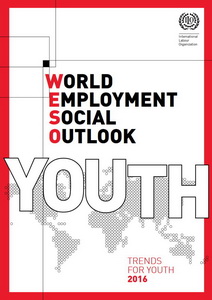 The global unemployment rate for youth is increasing once again after a number of years of improvement, reaching 13.1% in 2016 (compared to 12.9 in 2015), very close to its historical peak in 2013 (at 13.2 percent). It is expected to retain this value in 2017. As a result, after a decrease in unemployment for nearly 3 million workers between 2012 and 2015, the number of unemployed youth increased by around half a million in 2016, reaching 71 million. Forecasts state that the number of unemployed youth will remain at this level in 2017.
The global unemployment rate for youth is increasing once again after a number of years of improvement, reaching 13.1% in 2016 (compared to 12.9 in 2015), very close to its historical peak in 2013 (at 13.2 percent). It is expected to retain this value in 2017. As a result, after a decrease in unemployment for nearly 3 million workers between 2012 and 2015, the number of unemployed youth increased by around half a million in 2016, reaching 71 million. Forecasts state that the number of unemployed youth will remain at this level in 2017.
A large number of employed young people do not earn enough to escape poverty. In fact, around 156 million employed youth in growing economies and developing countries are living in extreme poverty (spending under $1.90 per day), or moderate poverty (spending between $1.90 and $3.10 per day). Additionally, young people have shown a far higher poverty rate for employed persons in 2016 than adults: 37.7 percent of employed youth have found themselves in extreme or moderate poverty, compared to 26 percent among adults. In addition to low salaries, young people often work against their will in informal employment, part time, and/or inadequate temporary and occasional jobs.
Faced with the risk of unemployment, poverty, and/or vulnerable employment, young people have a tendency of thinking about emigration to acquire better education and greater employment options. Over 50 million migrants in 2015 were aged 15 to 29 years, while 20 percent of the global population of youth in this age group stated they are prepared to relocate permanently to another country. Youth in poor countries typically show a higher tendency towards migration.
Increasing options for continued education and the acquisition of secondary education, as well as an increase in the enrolment rates for secondary schools, amounting to 75%, are the main drivers of positive developments, along with ways to acquire the required knowledge and skills, providing better jobs in the future. However, a large number of young people, particularly in developing countries, are unable to continue their education (e.g. due to the economic situation in the household), thereby entering the vicious circle of risk of poverty due to lack of access to better jobs. Since the youth unemployment rates remain stubbornly high, and transition from education into the labour market is increasingly difficult, the share of youth not in employment, education or training (NEET) is increasing. Surveys in 28 countries worldwide show that around 25 percent of the population aged 15-29 years belongs to the NEET category. Results also indicate the drastic increase of the NEET rate among youth, a particularly serious issue in developed countries.
Most labour market indicators show a significant disparity among young men and women. Although some areas and regions show modest improvements, progress is slow. For example, the share of young men in the labour force in 2016 amounted to 53.9 percent, compared to 37.3 percent for young women – representing a 16.6 percent gap. Young women are also faced with higher unemployment rates at the global level than young men. A total of 13.7 percent of young women were identified as unemployed in 2016 – an entire percentage higher than their male counterparts.
The Sustainable Development Agenda 2030 provides a unique opportunity to integrate a youth policy in the comprehensive sustainable development strategy. Improvements of outcomes for youth through the employment of young people and development of social policy are of key importance for an inclusive and sustainable society. To this end, four strategic goals within the Declaration on Social Justice for a Fair Globalization by the International Labour Organization, adopted in 2008 and evaluated in 2016, can help develop and shape national strategies for the employment of youth, combating the deficit of decent jobs for youth, addressing poverty and inequality and training youth to achieve equality and a prosperous future.
Source: World Employment Social Outlook – Trends for Youth 2016 (.pdf)
 Government of the Republic of Serbia
Government of the Republic of Serbia















 pdf [271 KB]
pdf [271 KB]
Leave a Comment